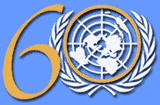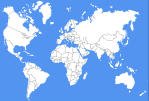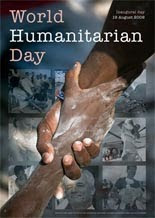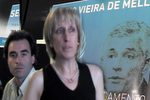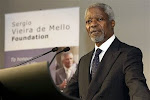
Jornada mundial da recusa da miséria
October 17, World Day to Overcome Extreme Poverty Recognised in 1992 by the United Nations as the International Day for the Eradication of Poverty
No dia 17 de Outubro de 1987, respondendo ao apelo do Padre Joseph Wresinski, cem mil pessoas reuniram-se no Adro das Liberdades e dos Direitos Humanos no Trocadéro em Paris para renderem homenagem às vítimas da fome, da violência e da ignorância, para afirmarem a sua recusa da miséria apelando a humanidade a unir-se para fazer respeitar os Direitos Humanos.
Uma LAJE proclamando esta mensagem foi inaugurada nesse dia e nesse Adro, onde em 1948 tinha sido assinada a Declaração Universal dos Direitos Humanos.
100.000 pessoas reunidas à volta do Adro dos Direitos Humanos, no Trocadéro (Paris) - 17 de outubro de 1987. Os cem mil cidadãos presentes eram pessoas de todas as origens, de todos os meios sociais e de todas as crenças. Algumas representavam as autoridades públicas internacionais, nacionais e locais. Outras eram famílias vivendo as realidades da grande pobreza à qual resistiam corajosamente no seu dia-a-dia.
A partir desta data, no dia 17 de Outubro de cada ano, os mais pobres e todos aqueles que, a seu lado, recusam a miséria e a exclusão reúnem-se, no mundo inteiro, com a finalidade de testemunharem a sua solidariedade e compromisso, para que os Direitos Fundamentais sejam restituídos aos mais pobres.
Assim nasceu a Jornada Mundial da Recusa da Miséria.
No dia 17 de Outubro de 1992, Javier Perez de Cuellar, então Secretário Geral das Nações Unidas, em nome de um grupo de personalidades internacionais, reunidas num Comité, lança um apelo para o reconhecimento do dia 17 de Outubro.
O Sr Javier Perez de Cuellar, secretário geral da ONU, com as famílias mais pobres no Adro do Trocadéro. Abril de 1989A 22 de Dezembro de 1992, o dia 17 de Outubro é proclamado Jornada Internacional para a Eliminação da Pobreza pela Assembleia Geral das Nações Unidas. A partir daí as inciativas para celebrar esta Jornada não cessaram de se multiplicar.
 A LAJE do Trocadéro assim como as suas réplicas tornou-se o símbolo da recusa da miséria, uma fonte de orgulho e de coragem para os mais pobres, assim como para os que se alinharam a seu lado.
A LAJE do Trocadéro assim como as suas réplicas tornou-se o símbolo da recusa da miséria, uma fonte de orgulho e de coragem para os mais pobres, assim como para os que se alinharam a seu lado.Vejamos :
"Por vezes a vida é dura, perde-se a esperança e deixa-se ir tudo por água abaixo. Desde que esta Laje foi inaugurada no coração de Paris, sabemos que alguma coisa mudou. Nunca mais ninguém poderá negar nem esquecer os que sofrem da miséria no mundo." "Esta Laje é para os que estão condenados a viver na miséria no mundo inteiro. Quando estamos sós, os esforços que fazemos não servem para nada. É preciso apoiar os que vivem na miséria tanto em França, como no resto do mundo e que, cada dia que passa, lutam para sobreviver. Juntemo-nos todos, para que toda a gente possa viver como ser humano." "Para mim, a Laje é coisa séria, a respeitar : nela damos existência a todas estas vidas de sofrimento e de coragem que não são reconhecidas por ninguém." "Foi um amigo que me convidou a vir até à Laje. Foi um grande choque para mim. Custava-me acreditar que homens, mulheres, famílias pudessem viver numa tal injustiça, dentro do meu próprio país...Com os meus colegas de trabalho, decidimos bater-nos, para que a nossa empresa desse trabalho e formasse trabalhadores sem qualificação." "A Laje é a nossa lança, o nosso cavalo de combate à pobreza. É um local, onde cada encontro provoca o nascimento de qualquer coisa de novo no coração das pessoas. É o local donde toda a espécie de pensamento, de palavra ou de acção menos correctos e que possam atingir a dignidade e a vida dos seres humanos devem ser banidos."
No dia 17 de Abril de 1989, Javier Perez de Cuellar, Secretário Geral das Nações Unidas, ao visitar a Laje e depois de ter lido a mensagem nela inscrita, declarava :
O Sr Javier Perez de Cuellar, secretário geral da ONU, com as famílias mais pobres no Adro do Trocadéro. Abril de 1989"Estou aqui como Secretário Geral das Nações Unidas e mais ainda como ser humano. Foi com uma profunda emoção que li as palavras do padre Joseph Wresinski. Esta inscrição inspira de modo permanente os nossos esforços, para que a pobreza seja vencida. Sou o representante da ONU, a organização que luta pela paz. Mas não creio que a paz consista somente na ausência de guerras. Não podemos falar de paz enquanto houver miséria no mundo. (...) Creio que é preciso ajudar o mundo inteiro a ter em consideração a miséria, tão dolorosa, de que sofrem tantos milhões de seres humanos. Venho de um país onde há muita miséria. Tenho, por conseguinte, uma muito especial compreensão das pessoas que precisam de ser ajudadas pela comunidade internacional no seu conjunto. Vivemos num mundo onde a interdependência é a palavra-chave. Dependemos uns dos outros. Os pobres dependem dos ricos, os ricos dependem dos pobres. (...) No que me diz respeito, não tenho nem poder material nem tão-pouco político. A ONU depende do governo dos Estados membros. No entanto, tenho uma força moral. E essa força ponho-a ao serviço desta causa de que o padre Wresinski foi e continua a ser, mesmo depois da sua morte, o porta-voz."
A Laje junto à sede das Nações Unidas em Nova Iorque
No seguimento de Javier Perez de Cuellar, a comunidade internacional começou a dar expressão ao seu empenho na luta contra a pobreza. Assim, no dia 22 de Dezembro de 1992, a ONU reconhece o dia 17 de Outubro como Jornada Mundial para a Eliminação da Pobreza e, no dia 17 de Outubro de 1996 uma réplica da Laje do Trocadéro é inauguarada na sede das Nações Unidas, em Nova Iorque.
No dia 21 de Agosto de 1997, o Papa João Paulo II, aquando das Jornadas Mundias da Juventude em Paris, começa por se recolher junto da Laje do Trocadéro e aí recebe uma delegação de jovens do Quarto Mundo.
De um bairro de lata (favela) até ao Primeiro Decénio das Nações Unidas para a Eliminação da Pobreza
1956 : O padre Joseph Wresinski chega ao bairro de lata (favela) de Noisy-le-Grand.
“Aqui as famílias encontram-se reunidas pela miséria... De imediato, senti que me encontrava frente ao meu povo”.
O Dia Mundial da recusa da miséria encontra as suas origens num agrupamento de famílias em situação de grande pobreza que viviam num bairro de lata (favela), em Noisy-le-Grand, nos arredores de Paris. O padre Joseph Wresinski, homem nascido na miséria, no mês de Julho de 1956 decide ficar junto destas famílias. Com elas fundará em 1957 uma associação que se tornará mais tarde o Movimento ATD Quarto Mundo.
Mal chegou a Noisy-le-Grand, fez a promessa de levar este povo reunido pela miséria a subir os degraus de todos os sítios, onde os homens e mulheres tomam decisões sobre o futuro, tais como o Eliseu, o Vaticano e as Nações Unidas. Queria assim garantir a estas famílias um reconhecimento e uma existência no interior das consciências.
Estas famílias, isoladas e excluídas do mundo dos homens, precisavam que alguns membros da sociedade a elas se juntassem para, em união com elas, recusarem a condição de exclusão de que eram vítimas. Assim nasceu uma história de parceria entre famílias excluídas e cidadãos reconhecidos e estabelecidos na sociedade.
17 de Outubro de 1987 : as famílias mais pobres do mundo têm finalmente um local, universalmente reconhecido.
Esta história está na origem do grande agrupamento de 100.000 pessoas, no dia 17 de Outubro de 1987, em Paris, no Adro das Liberdades, dos Direitos Humanos e do Cidadão. Respondendo ao apelo lançado pelo padre Joseph Wresinski, estas pessoas afirmaram a necessidade de se unirem para fazerem respeitar os Direitos Humanos, reconhecendo que a miséria é uma negação permanente de todos eles. Esta afirmação foi materializada numa Laje em homenagem às vítimas da miséria, colocada neste adro, onde em 1948 foi assinada a Declaração Universal dos Direitos Humanos. A inauguração desta Laje foi um marco importante na história do reconhecimento das famílias mais pobres cuja existência tinha sido, até ali, ignorada, tanto na vida política, como social e cultural de seus países.
A partir daí, no dia 17 de Outubro de cada ano, cidadãos de todas as origens, condições e convicções passaram a reunir-se à volta desta Laje para darem testemunho da sua solidariedade para com os mais pobres e assim renovarem o seu compromisso. A partir de 1988, reuniões como esta passaram a ser organizadas através do mundo, tanto no interior das comunidades locais, como nos bairros de miséria espalhados por todos os continentes.
Assim nasceu uma verdadeira Jornada Mundial da Recusa da Miséria, por iniciativa dos mais pobres do mundo inteiro.
1992 : As Nações Unidas reconhecem o Quarto Mundo, assim como o seu contributo para a construção da humanidade.
No dia 22 de Dezembro de 1992, a Assembleia Geral das Nações Unidas adopta uma resolução que proclama o dia 17 de Outubro como “Jornada Internacional para a Eliminação da Pobreza”, confirmando, deste modo, o contributo das famílias mais pobres para a construção do mundo.
No dia 17 de Outubro de 1994, as famílias do Quarto Mundo, reunidas em Congresso nos Estados Unidos da América, foram recebidas pelo Secretário Geral das Nações Unidas que assim dava um real significado ao reconhecimento pela ONU das famílias mais pobres, como parceiros de direito.
1996 - 2006 : As famílias mais pobres são reconhecidas como parceiros na construção do mundo de amanhã.
As Nações Unidas designaram oficialmente 1996 como “Ano Internacional para a Eliminação da Pobreza”, o que constituiu em si uma etapa importante na longa caminhada das famílias mais pobres para serem acolhidas como parceiros indispensáveis nos locais, onde os homens e mulheres costumam reunir-se para reflectir e tomar decisões sobre o futuro. Através do decénio (1997 -2006) as Nações Unidas permitem que esta história de uma nova fraternidade entre todos os homens, a partir dos mais pobres, continue a ser escrita. Hoje, está ao alcance de todos e todas que o desejarem associar-se a esta corrente mundial.
Fonte,http://www.oct17.org/Historia-do-dia-17-de-Outubro.html, consultado a 11 de Outubro de 2009.


